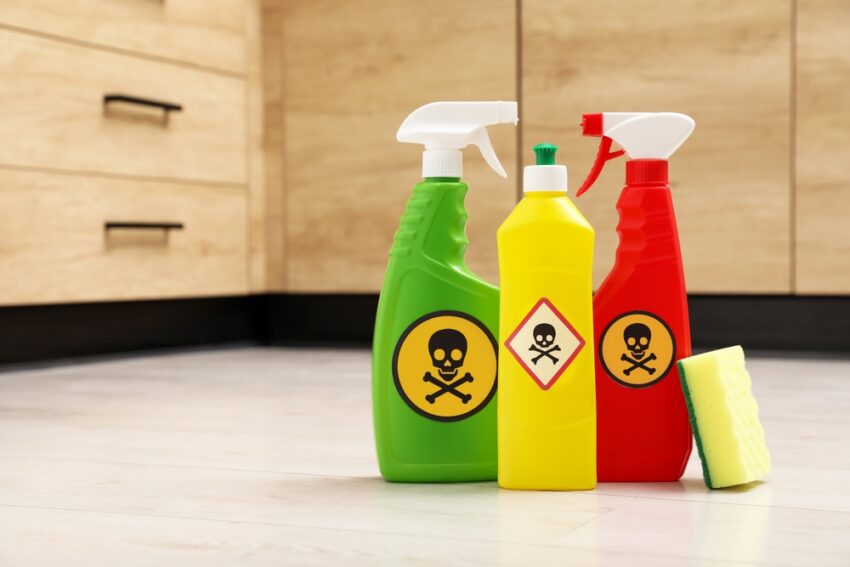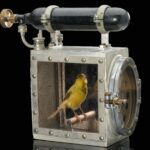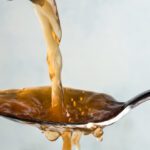
Bleach alternatives
For disinfecting cages and toys and other things birds use, bleach is likely the most popular choice. Bleach has a reputation for being an excellent disinfectant, and it’s very effective against both bacteria and viruses.
However, there are significant downsides to using bleach as well as equally effective alternatives.
Birds and inhaled toxins
You’ve heard of expression “canary in the coal mine”? Maybe you didn’t know it’s a real thing!
Well into the 20th century, coal miners brought canaries into coal mines as an early-warning signal for toxic gases, primarily carbon monoxide. The birds, being more sensitive, would become sick before the miners, who would then have a chance to escape or put on protective respirators.
Sentinel species—Wikipedia
There is at least one modern study that suggests the same thing.
Birds are ubiquitously distributed in essentially all of the environments inhabited by humans; thus, if we understood the effects of a broad range of inhaled environmental contaminants (gas and particulate) on a wide variety of avian species, they could serve as highly effective and sensitive monitors of air quality.
The avian respiratory system: a unique model for studies of respiratory toxicosis and for monitoring air quality—Environmental Health Perspectives—February 1997
So when you smell something caustic or fragrant or strong, you should be concerned about the effect on your birds.
Bleach
I’ll start with the general assessment of toxicity.
Sodium and calcium hypochlorite are extremely corrosive and can cause severe damage to the eyes and skin. They have been assigned to Toxicity Category I [“highly toxic and severely irritating”].
Sodium and Calcium Hypochlorite Salts—US Environmental Protection Agency
The EPA recommends never using bleach around children. Yes, really.
There are safer products available. For this reason, we are not recommending the use of bleach in Early Care and Education (ECE) to sanitize and disinfect.
Green Cleaning, Sanitizing, and Disinfecting: A Curriculum for Early Care and Education—US Environmental Protection Agency
And here’s why it’s bad.
We now know that exposure to bleach can make asthma worse in people who already have asthma. Research shows that workers who are exposed to bleach can develop new asthma from exposure to bleach over time.
It can also irritate the skin, eyes, and respiratory tract.
What’s the problem with bleach?—US Environmental Protection Agency
We’ve been told stainless steel is one of the best materials to use around birds. How does bleach work for cleaning it?
Bleach corrodes [rusts] many metals. It should never be used on stainless steel, aluminum, copper, brass, marble, or granite.
What’s the problem with bleach?—US Environmental Protection Agency
Oh, and it gets better.
Never mix bleach or any bleach-containing product with any cleaner containing ammonia. The gases created from this combination can lead to chronic breathing problems and even death.
Cleaning Supplies and Household Chemicals—American Lung Association
One final note is that you’re supposed to dilute bleach, at least 10:1 before using it. But how many people know this? If you don’t, everything you read here about bleach is 10x worse.
So, before looking at alternatives, what does the EPA chart say about bleach?
Bleach
If used for disinfecting purposes, bleach should not be stored more than 3 months. When mixed with water, the solution is only effective as a disinfectant for 24 hours.
Effective against most bacteria and some viruses and is registered as effective against HIV, HBV, H1N1 (influenza A), MRSA, and TB.Mixing with ammonia, ammonium quaternary compounds and other acidic products can create poisonous gas.
Suspected cardiovascular, gastrointestinal or liver, kidney, central nervous system, respiratory, and skin or sense organ toxicant.
Protection equipment or increased ventilation should be used.
Toxic to aquatic organisms.
May damage floor finishes, carpet, clothing, and other fibers.
Has an unpleasant odor.
Rinsing is required in applications where direct skin or oral contact can occur (children’s toys).
EPA Registered Hard Surface Disinfectants Comparison Chart
Alternatives
There are a surprising number of bleach alternatives that are classified as disinfectants, meaning they have been evaluated by the EPA to kill 99.999% of all germs.
I’ll describe three here that are classified as Category IV, the lowest category of concern by the EPA (“Practically non-toxic and not an irritant”).
Accelerated Hydrogen Peroxide
I’ll start by mentioning that this is used as a bleach alternative by the Peninsula Humane Society, one of the largest animal shelters in the country. Here’s what the EPA chart says about it. It’s widely available. Just search for accelerated hydrogen peroxide.
Here’s what the EPA says about it:
Accelerated Hydrogen Peroxide
Effective against a broad spectrum of microbes including H1N1 microbes (Influenza A), norovirus and MRSA.
Rinsing is required where direct skin and oral contact can occur (children’s toys). [Note this is the same warning bleach has]
Stable in storage. 2 year shelf life.
Regular ventilation is adequate.
Non-corrosive in diluted form.
Some products using this technology have been third-party certified by EcoLogo to meet environmental and human health criteria.
Some products are odorless.
EPA Registered Hard Surface Disinfectants Comparison Chart
Silver Dihydrogen Citrate
This product is very difficult to find, but it’s worth noting since it has a lot of advantages.
Silver Dihydrogen Citrate
Effective against a broad spectrum of microbes including MRSA, novovirus, and H1N1 (influenza A)
Stable in storage, no expiration date.
Listed on the Grassroots Environmental Education’s ChildSafe Products list.
Non-corrosive
Odorless.
No rinsing is required.
No warning or first aid statements are required on the label.
EPA Registered Hard Surface Disinfectants Comparison Chart
Thymol
I’ve saved my favorite for last. Thymol not only gets the stamp of approval by the EPA, but there are decades of research behind its safety and efficacy for a wide variety of purposes including disinfection. Here’s the EPA information.
Thymol
Effective against a broad spectrum of microbes including MRSA, TB, and H1N1 (influenza A).
Stable in storage. 2 year shelf life.
No warning or first aid statements are required on the material safety sheet.
The botanical oils in the product are either FDA approved as food additives or on the GRAS (Generally Recognized As Safe) list.
Some products using this technology have been third-party certified by EcoLogo to meet environmental and human health criteria.
Regular ventilation is adequate.
Strong odor.
Non-corrosive.
No rinsing or wiping is required.
Approved by the Canadian Food Inspection Agency for use in food processing.
Suitable for use on children’s toys.
EPA Registered Hard Surface Disinfectants Comparison Chart
There’s also some amazing research into Thymol as a therapy for anything from cancer to anxiety to diabetes to epilepsy. To top it off, the same research paper reports that “thymol produced a significant increase in antibody titers against the Newcastle disease virus in broiler chickens”. Wow.
In my mind, Thymol is the best choice except for one problem that some people have with the product: the odor. Some people hate it, some people love it, some people are indifferent. It’s certainly better than bleach but keep that in mind if trying this product.
Seventh Generation (I’m not an Amazon affiliate) makes several products including a spray and a wipe that contain thyme oil. Be sure to check the ingredients!
Summary
The summary is easy. Don’t use bleach anymore. Ever ever ever. There’s no compelling reason to continue. There are far safer alternatives that are just as effective without the downsides. You will irritate your own respiratory tract and your birds will suffer even more.
My recommendation would be for a Thymol-based product first, but if you don’t like the smell, go with accelerated hydrogen peroxide. The silver dihydrogen citrate option is not yet a real option due to lack of products.




